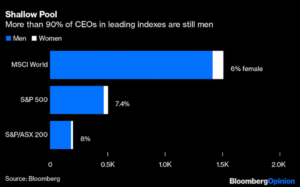‘Fig-Leaf Feminism’ Is Holding Back C-Suite Parity
When Citigroup Inc.’s Jane Fraser pulled out of a forum of global financial leaders in Hong Kong, it left the marquee event with virtually no female speakers. More than that, it once again highlighted how still very few companies are run by women.
Fraser was supposed to be one of only three female panelists at the Global Financial Leaders’ Investment Summit heralding the reopening of Hong Kong after almost three years of stringent Covid quarantines and tightening political oversight from Beijing. Amundi SA Chief Executive Officer Valerie Baudson was another, but she also dropped out.
That’s why it’s time to shift the discussion beyond the boardroom to the C-suite. It’s no longer enough for companies to pat themselves on the back for adding women to their boards. They need to prioritize getting — and retaining them — in line management roles with profit-and-loss responsibilities — that traditionally lead to CEO. And investors, for their part, need to train their lens on how firms achieve that, pushing for policies that boost gender balance in executive ranks.
Despite more gender-diverse boards in the US, Europe, Australia, and soon Hong Kong, when it comes to the top job, women remain grossly underrepresented. More women around the board table, at some point, may also stop being seen as a yardstick for meaningful progress because it won’t reflect diversity in all its hues. In the US, for example, women of color fare even worse in the leadership pipeline.
Only 37 — or 7.4% — of the S&P 500’s 503 companies are led by women. There are only 16 female CEOs in the S&P/ASX 200 Index in Australia, a mere 8%. Globally, only 6% of the 1,507 firms in the MSCI World Index had female leaders as of the end of November, all according to data compiled by Bloomberg.
In Australia, where female board representation is now well above 30%, it’s estimated it will take 100 years for women to make up at least 40% of all CEO positions at the 200 biggest companies. Among the 300 largest, more have no women in their executive leadership teams this year than last year, and of 28 CEO appointments in 12 months only four were female, according to the Chief Executive Women Senior Executive Census 2022.
Companies are struggling to hold on to the few female leaders they have in the US. The Women in the Workplace 2022 report by McKinsey & Co. and LeanIn.Org found women leaders are switching jobs at the highest rates ever in what’s being described as the “The Great Breakup.” That leaves too few to promote to senior leadership: only 87 women are elevated from entry-level roles to manager positions for every 100 men.
Missing out on the perspective and contribution of 50% of the population is not smart. Not for business, not for gender equality, and not for corporate governance. It also sends a dismal message for future generations of aspiring female leaders. And it does nothing toward fixing the gender pay gap that on average remains just above 10% for OECD countries.
Boards can ensure that not only are they diverse, but that women wield the same influence as men and don’t just represent token additions — a tendency labeled “fig-leaf feminism” by researchers from the University of Technology Sydney and the University of Alberta. Female directors must be allowed to have agency, their skills and expertise utilized, and their opinions listened to. That way they can have a greater say and influence over how companies achieve gender balance at every level of their executive tiers. Boards also need to cast wider for potential female appointees. While women hold more seats, a study by the researchers found that’s not matched by an increase in the actual number of females, suggesting the same names sit on multiple boards.
